In monumental murals and iconic prints, Charles White captured the humanity of black America at a time when simply doing so was a radical political gesture. Getting his start as a precocious young draftsman in Chicago, White would gain employ under the WPA—a job that forced him to complete a painting every month for three years. He moved to New York with his first wife, fellow artist Elizabeth Catlett, where he fell in with the luminaries of the Harlem Renaissance; the couple then went to Mexico City at the invitation of David Alfaro Siqueiros, working for a year at his influential printshop. White called his exposure to overtly political Mexican artists the single most profound influence on his career. While all of this history has led to his general categorization under “social realism,” I find the term a bit limiting, perhaps even with derogatory connotations meant to put down artists who rejected modernist purity and infused their work with activism and narrative. However, White’s immense talent—seen here in his incredible mix of velvety chiaroscuro and deft, lively line—was channeled as much toward politics as toward aesthetic beauty. “All my life, I’ve been painting a simple painting,” he once said. “This does not mean that I am a man without anger—I’ve had my work in museums where I wasn’t allowed to see it. But what I pour into my work is the challenge of how beautiful life can be.”
Charles White, Mother and Child, 1953
critical-objects: In monumental murals and iconic prints, Charles White captured the humanity of black America at a time when simply doing so was a radical political gesture. Getting his start as a precocious young draftsman in Chicago, White would gain employ under the WPA—a job that forced him to complete a painting every month for…

Leave a Reply